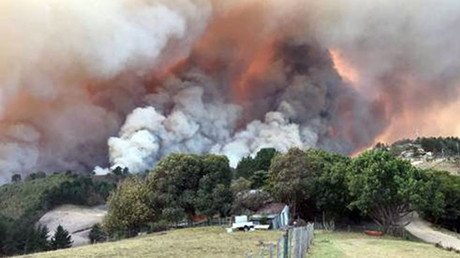Countdown to Day Zero: Why is Cape Town running out of water? (VIDEOS)
Cape Town is counting down to ‘Day Zero,’ when the city’s water supply will run critically low. Many lament government inefficiency, while others blame climate change, but what has really pushed the city to its limit?
Day Zero is the point when the city government will turn off most of the water distribution systems, rationing what's left for essential services. At the time of writing, the event is predicted to take place on July 9. Dam levels are currently at 24 percent; Day Zero protocols will be triggered when the dams reach 13.5 percent capacity.
“A severe drought is to blame for the current crisis, more than either government or citizens,” City of Cape Town Executive Deputy Mayor, Alderman Ian Neilson, told RT.com. “Since implementation of the Water Conservation and Water Demand Management (WCWDM) Strategy, overall consumption for the City of Cape Town has remained fairly level despite population growth of approximately 30 percent.”
Thank you for your continued effort to #ThinkWaterCT. Our current average daily usage has been reduced to 516 million litres. With dam levels at 24%, it’s more important than ever to not exceed 450 million litres per day. View this week’s dashboard here: https://t.co/Yj9ZUoU0UDpic.twitter.com/owSq7a5ZQh
— City of Cape Town (@CityofCT) March 2, 2018
“Low rainfall has, however, persisted longer than any of the hydrological models could have anticipated. In other words, this drought is worse than the modelling of the supply system made allowances for. This is being seen by many as a signal that we are starting to feel the effects of climate change,” Neilson added.
Some have blamed inefficiency and bureaucracy at the National Department of Water and Sanitation, which failed to approve new water projects in a timely manner. The department reportedly collapsed under the mismanagement of former minister Nomvula Mokonyane.
Safety and Security mayoral committee member JP Smith believes the national government is failing in its responsibilities and is putting undue pressure on the city government to spend its own funds to avert disaster.
“Water is the most recent example of this [governmental] meltdown. For us it’s an incredibly difficult challenge and we’re being put under tremendous pressure. The national government will need much bigger budgets,” Smith said, as cited by Ground Up. One major criticism of the government’s response is that previous remediation measures have focused too heavily on the demand and not the supply side of the problem.
Day Zero calculations are based on rainfall patterns from 2017 which was far below average rainfall. It has, however, been described as the "new normal."
“Of course‚ the one factor we are still unable to predict is the rainfall expected this winter. We have therefore drafted three different scenarios for Day Zero‚ based on no rainfall‚ rainfall at 100 percent and rainfall at 85 percent of the rainfall received in 2017‚” said Neilson.
Normal Cape Town water consumption for the hot summer month of February is roughly 1,200 Million Liters per Day (MLD). The city has managed to reduce current consumption levels by 50 percent thanks to a disaster management strategy that has been put in place, including rationing and other remediation measures that have been enacted but the city is still falling well short of consumption targets. Daily water allocation stands at just 50 liters per person.
Citizens are encouraged to have stop-start showers and flush the toilet just once per day, preferably using ‘grey water’ (household wastewater excluding water that has been contaminated with fecal matter). Public pools, spray parks and fountains have all been shut down citywide.
Meanwhile, the city is desperately trying to find alternative, long-term solutions to the problem including exploiting nearby aquifers, treating and repurposing wastewater as well as constructing new desalination plants. However, seven of eight alternative water source projects are currently behind schedule though six are expected to feed water into the system before the projected July 9 Day Zero.
For example, authorities believe the Atlantis and Silwerstroom aquifers will eventually contribute an extra five million liters into the system. Once desalination and aquifer extraction programs are fully online, city officials expect they will add an additional 180 million liters of water per day to the supply.
Citizens of Cape Town have shown unprecedented levels of co-operation in managing the region’s water crisis, say members of UCT’s Environmental Policy Research Unit. Read more: https://t.co/mrGhof9Zw4pic.twitter.com/0lCDhXCBHA
— UCT (@UCT_news) March 2, 2018
In the event that all precautionary measures fail, the Zero Day protocol will establish 200 water distribution points across the city. However, according to one system dynamics model, it would take 12.5 hours per day to provide the requisite amount of water per person to every member of the city's population that requires assistance, assuming no disruptions to supply and near total efficiency in delivery without any conflict at the distribution points.
The analysis suggests doubling the number of distribution points or increasing the number of taps per distribution point but even so, the system cannot account for 'random shocks,' such as spontaneous outbreaks of violence, which will disrupt operations. The current Cape Town population is estimated to be 4 million, with 700,000 people living in areas which will not experience water supply disruptions, including strategic sites such as hospitals and "informal settlements."
READ MORE: ‘Thought-police scientists shutting down factual climate change debate’ – Ex-Aussie PM
An additional 800,000 people live near these settlements and can likely source most, if not all, of their required water there. Based on these rough assumptions, 2.5 million people will rely on the water distribution points. There will be roughly 200 points with an average of 50 taps per site.
An individual is allowed to collect up to 100 liters a day to cover four days' consumption or to share with members of their household. Water pressure is assumed to be at 10 liters per minute, 2 minutes 30 seconds per person with a 30-second changeover leaving little margin for error, especially with a thirsty and understandably irritable population.
City authorities are hoping to avoid Day Zero altogether, however. “Provided residents use water within the required limits, we do not foresee that implementation of water collection points will be necessary,” Neilson says.
Think your friends would be interested? Share this story!















